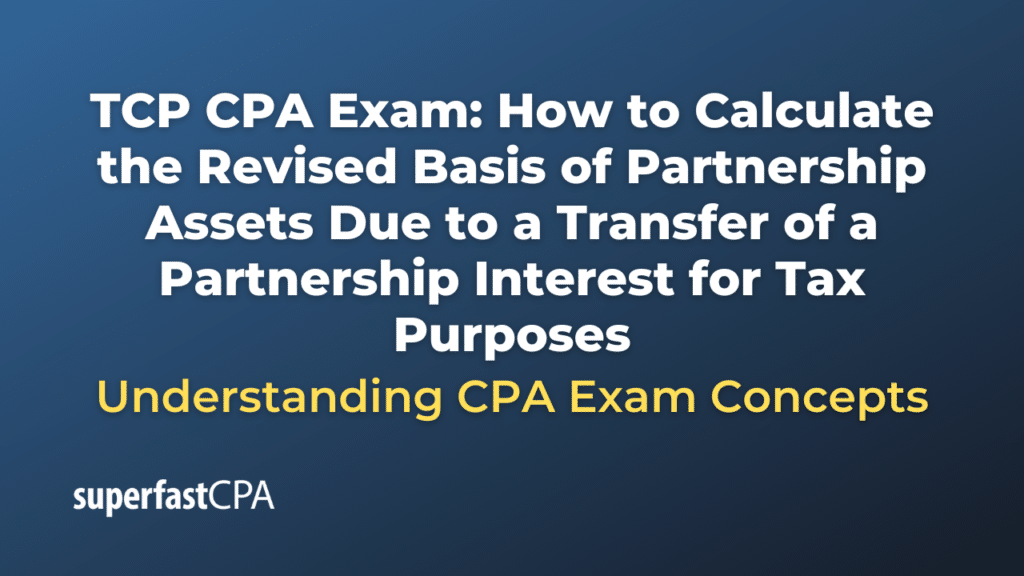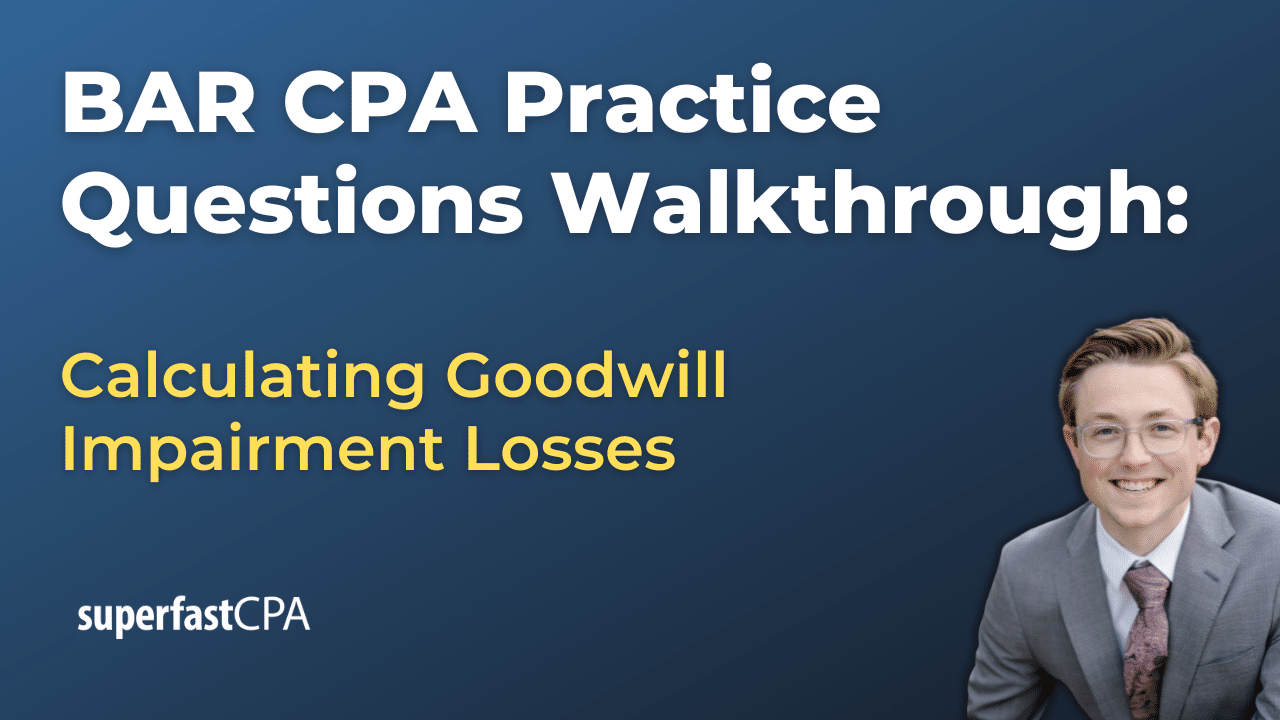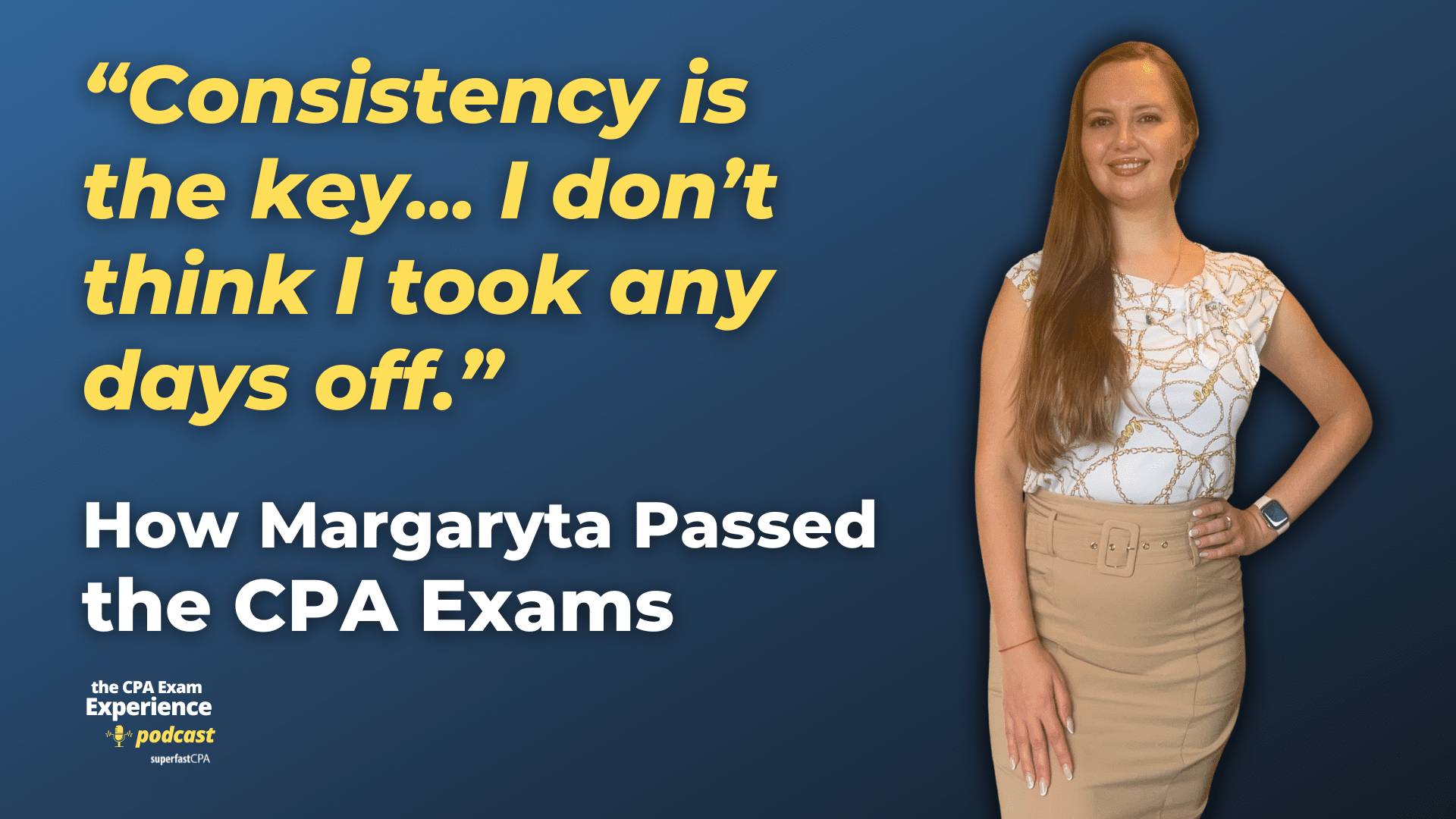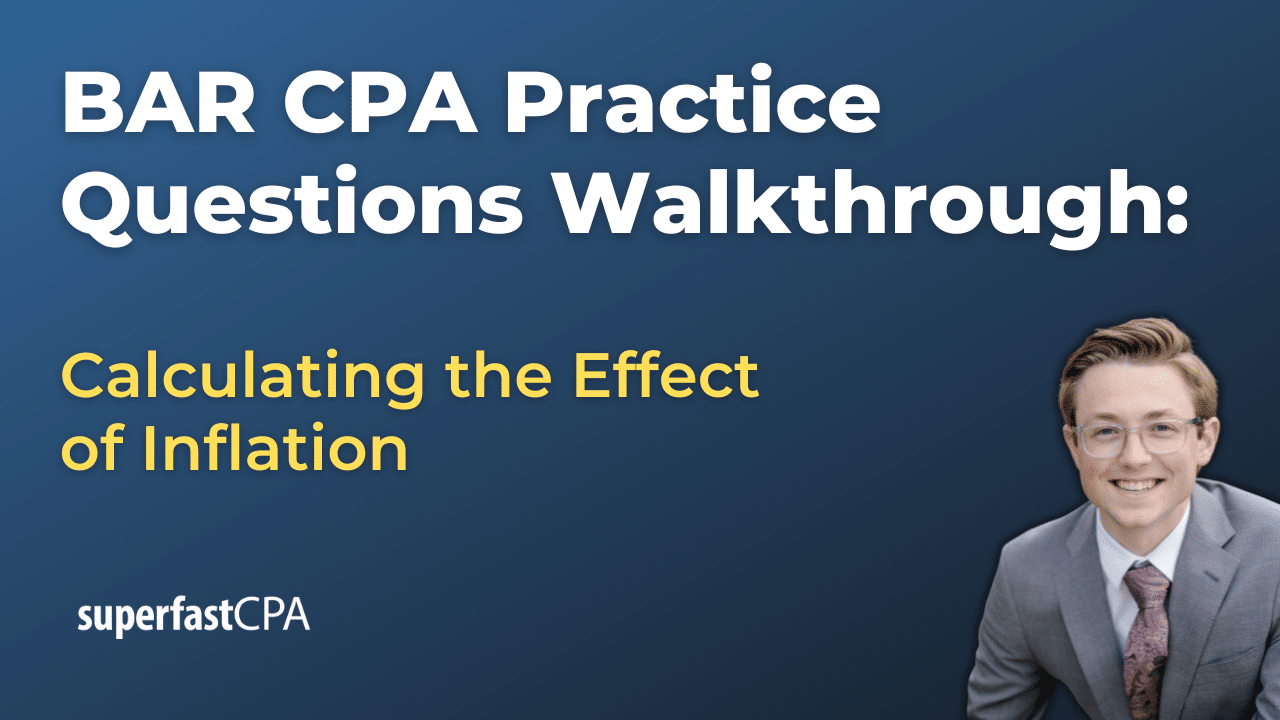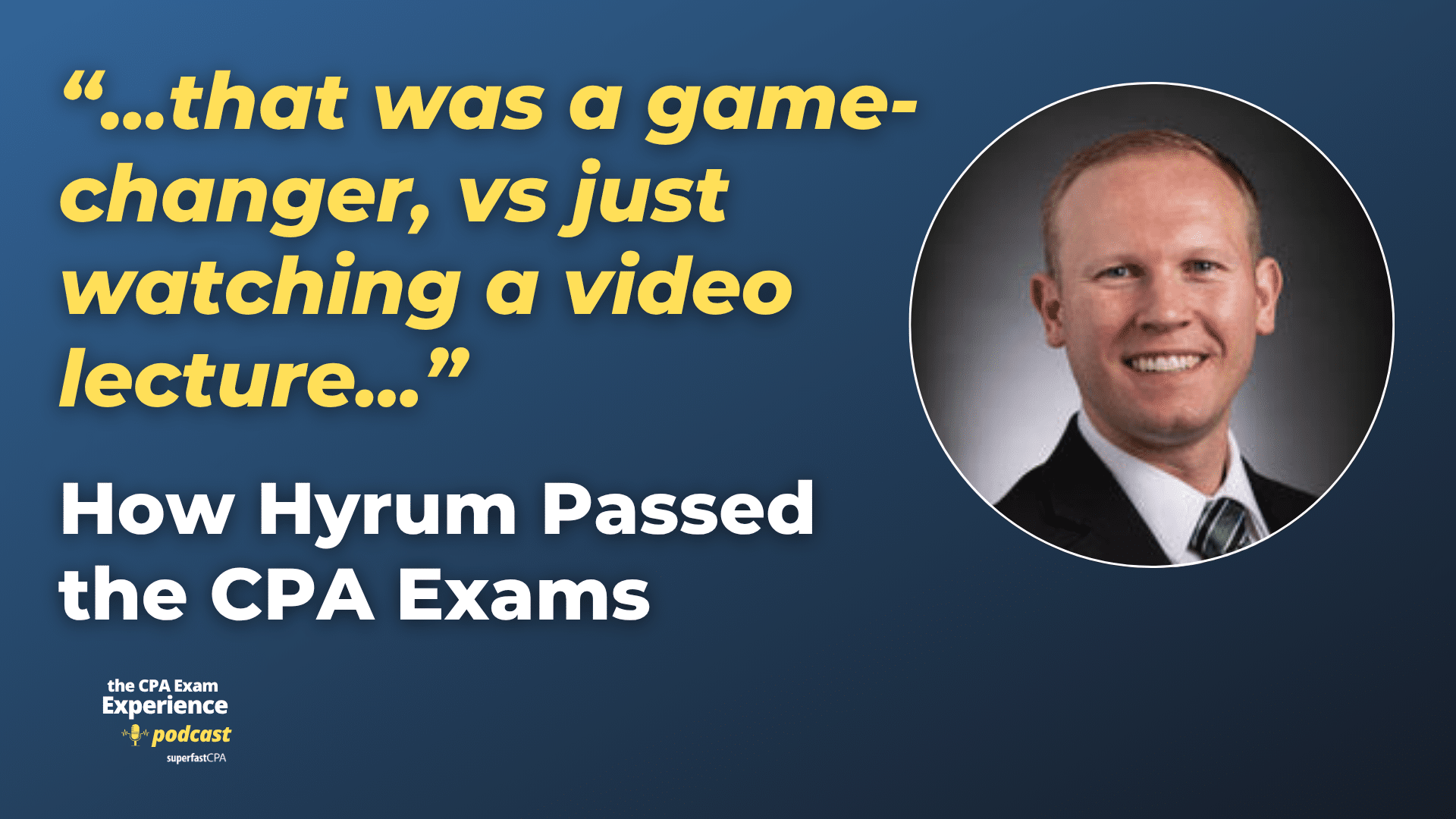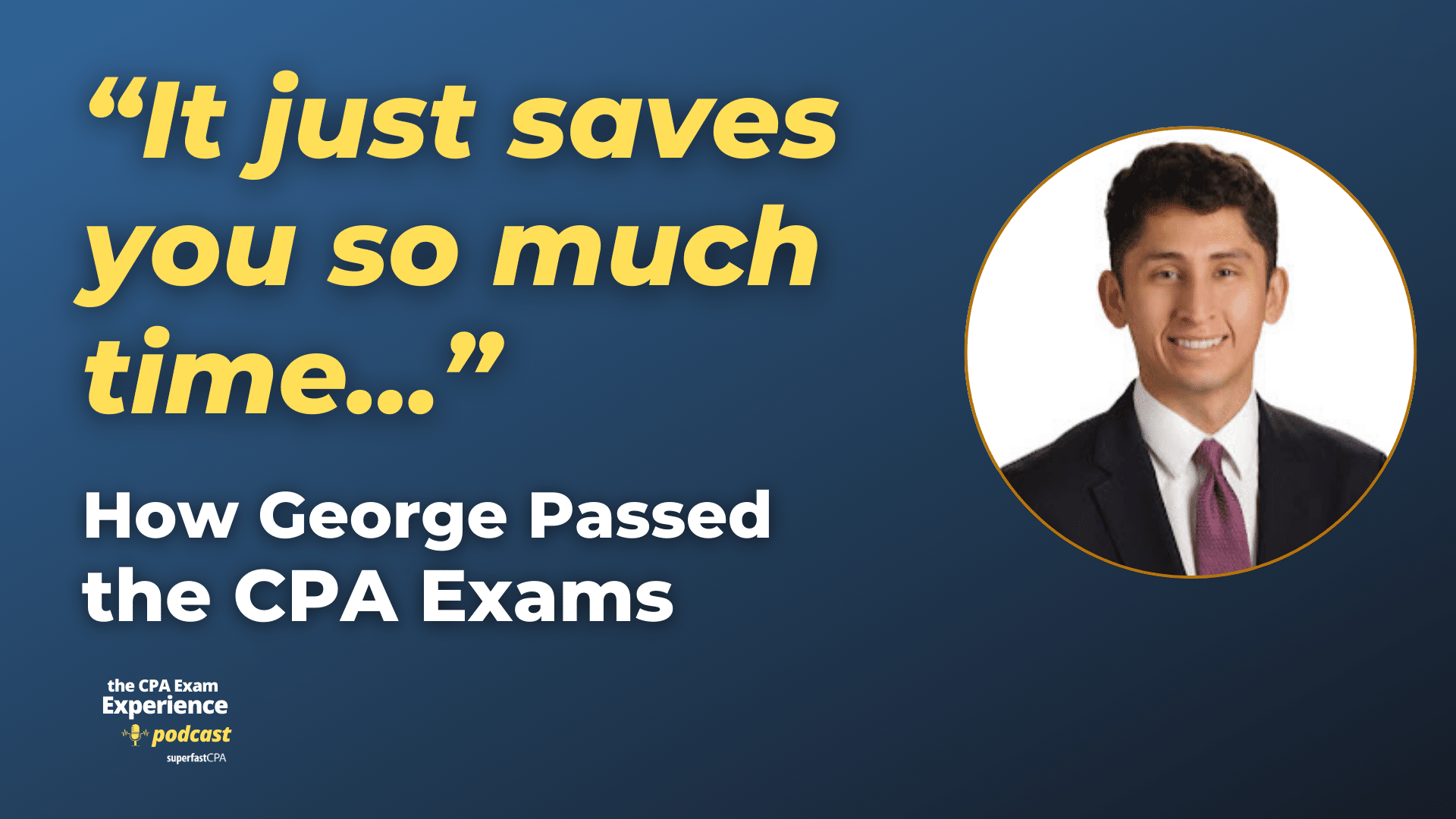Introduction
Brief Overview of Partnership Taxation
In this article, we’ll cover how to calculate the revised basis of partnership Assets Due to a Transfer of a Partnership Interest for Tax Purposes. In the world of partnership taxation, the Internal Revenue Code (IRC) outlines how partners and partnerships are taxed separately, with each partner reporting their share of the partnership’s income, deductions, and credits on their individual tax returns. Unlike corporations, partnerships are not taxed as separate entities; instead, the partnership is considered a “pass-through” entity, where income and other tax items flow through to the individual partners.
The tax treatment of assets within the partnership, as well as a partner’s interest in the partnership, plays a critical role in determining how gains, losses, and deductions are distributed. When a partnership interest is transferred—whether through a sale, exchange, or inheritance—the tax implications for both the outgoing and incoming partners must be carefully considered. Specifically, the basis of the partnership’s assets can change, directly affecting how future income, deductions, and distributions are reported.
Importance of Understanding Basis Adjustments
Understanding how to adjust the basis of partnership assets due to a transfer of a partnership interest is essential for maintaining proper tax compliance and avoiding unintended consequences. Basis, in simple terms, refers to the partner’s investment in the partnership, and it serves as the starting point for determining gain or loss on subsequent transactions.
When a partnership interest is transferred, the new partner often steps into a different economic position from the previous partner, particularly if the market value of the partnership’s assets has changed. This can create a disparity between the new partner’s outside basis (the partner’s basis in their partnership interest) and the inside basis (the partnership’s adjusted basis in its assets). If left unadjusted, this discrepancy can lead to inaccurate reporting of income, depreciation, and gains or losses on asset dispositions.
To address this issue, the IRC allows for the adjustment of the partnership’s inside basis through mechanisms such as the Section 743(b) adjustment, which helps align the new partner’s outside basis with their share of the partnership’s inside basis. Making these adjustments is critical because it ensures that tax attributes, such as depreciation and amortization, are correctly allocated, preventing over- or underreporting of taxable income. Additionally, basis adjustments are particularly important when the partnership has appreciated or depreciated assets, as they directly affect the tax consequences for future transactions involving those assets.
Understanding how to revise the basis of partnership assets not only helps in complying with tax laws but also optimizes the tax position of both the partnership and its partners, making it a crucial area of focus for those studying for the TCP CPA exam.
Transfer of a Partnership Interest
Definition and Types of Partnership Interest Transfers
A transfer of a partnership interest occurs when a partner sells, exchanges, or otherwise disposes of their ownership stake in the partnership. This transfer can happen voluntarily, such as through the sale of a partner’s interest to another individual or entity, or involuntarily, such as when the interest passes to a beneficiary upon a partner’s death. In either case, the transfer has tax implications for both the outgoing and incoming partner, as well as for the partnership itself.
Partnership interest transfers generally fall into two categories:
- Sale or exchange of partnership interest: In a sale or exchange, the partner transfers their share of the partnership to another party in exchange for consideration, typically in the form of cash or property.
- Transfer due to death or gift: In certain cases, a partner’s interest may be transferred without consideration, such as through inheritance or a gift. This scenario often triggers different tax rules and may affect basis calculations in unique ways.
Sale or Exchange of Partnership Interest
When a partner’s share in the partnership is sold or exchanged, the transaction is treated as the sale of a capital asset for tax purposes. This means that the outgoing partner will recognize capital gain or loss based on the difference between the amount received from the sale and their outside basis in the partnership. The outside basis represents the partner’s adjusted basis in their partnership interest, which generally reflects their initial investment, increased by any income allocated to them, and decreased by any distributions or losses.
From the perspective of the incoming partner, the purchase price or fair market value of the interest becomes the new partner’s outside basis in the partnership. However, this outside basis may not match the partnership’s inside basis—which is the partnership’s adjusted basis in its underlying assets. This mismatch often necessitates a basis adjustment, particularly if the partnership has appreciated or depreciated assets, to ensure that income and losses are properly allocated.
Effect on the Incoming and Outgoing Partners
The outgoing partner is affected by the transfer in terms of the gain or loss recognized from the sale of their interest. This gain or loss is calculated by comparing the amount realized from the sale (typically cash or property received) with their outside basis. Additionally, the outgoing partner is relieved of their share of the partnership’s liabilities, which also factors into the calculation of the amount realized.
The incoming partner, on the other hand, steps into a new economic position within the partnership. While the incoming partner receives a new outside basis based on the amount paid for the interest, the partnership’s inside basis in its assets remains unchanged unless a Section 754 election is in effect. This can create a disconnect between the new partner’s outside basis and their proportionate share of the partnership’s inside basis, which can affect their future tax consequences. To resolve this, a basis adjustment under Section 743(b) may be necessary, ensuring that the incoming partner’s outside basis and share of inside basis are aligned for tax purposes.
The transfer of a partnership interest through sale or exchange has significant tax implications for both the outgoing and incoming partners. Properly managing the basis of the partnership’s assets following a transfer is critical to ensuring accurate tax reporting and optimizing tax outcomes for all parties involved.
Impact on Partnership Basis
Inside and Outside Basis
In partnership taxation, the concepts of inside basis and outside basis are essential for understanding the tax implications of a partner’s interest and the partnership’s assets. These two bases operate together to determine how income, losses, and other tax items are distributed among the partners and how gains or losses are recognized when partnership interests or assets are transferred.
Definition of Inside Basis
The inside basis refers to the partnership’s adjusted basis in its assets. This basis is determined by the original cost or value of the assets when acquired by the partnership, adjusted for depreciation, improvements, and other factors. The inside basis represents the partnership’s ongoing tax basis in the property it holds, which is critical for calculating depreciation, amortization, and the gain or loss when an asset is sold or disposed of.
Each asset owned by the partnership has its own inside basis, which is adjusted over time based on the partnership’s operations. When a partnership sells an asset or uses it in business activities, the inside basis helps determine the amount of taxable income or loss attributed to each partner.
Definition of Outside Basis
The outside basis is the adjusted basis of an individual partner’s interest in the partnership. This basis reflects the partner’s investment in the partnership and is used to determine the tax consequences when the partner sells or transfers their partnership interest or receives distributions.
A partner’s outside basis is initially set by their contribution to the partnership—whether cash, property, or services—and is subsequently adjusted by their share of partnership income, losses, deductions, and any distributions received. It also takes into account the partner’s share of the partnership’s liabilities, which increase or decrease the outside basis.
Outside basis is essential for calculating the gain or loss on the sale or transfer of a partnership interest and for determining the taxability of distributions received by the partner. If a partner’s outside basis is fully reduced, further distributions may result in taxable gains.
Connection Between Inside and Outside Basis
Although the inside and outside bases are related, they are not necessarily equal. The inside basis is tied to the partnership’s assets, while the outside basis reflects each partner’s individual interest in the partnership. These two values often differ due to a variety of factors, such as changes in asset values, depreciation, or contributions of property by partners.
A transfer of interest, such as a sale or exchange, typically triggers a review of these bases. When a partner transfers their interest, the incoming partner’s outside basis is generally based on the purchase price or fair market value of the interest acquired. However, the inside basis of the partnership’s assets remains unchanged unless the partnership makes a Section 754 election. This election allows for a Section 743(b) adjustment, which aligns the inside basis of the partnership’s assets with the new partner’s outside basis.
Without a Section 754 election, the incoming partner may face discrepancies between their outside basis and their share of the inside basis, which could affect future deductions (such as depreciation) and the recognition of gains or losses on the sale of partnership assets. The election ensures that the new partner’s share of the inside basis matches their outside basis, preventing over- or under-reporting of taxable income in the future.
Understanding the relationship between inside and outside basis is critical for both the partnership and its partners, as it affects the taxation of income, gains, losses, and deductions, as well as the calculation of gain or loss on the transfer of partnership interests.
Section 743(b) Adjustment
Overview of Section 743(b)
Section 743(b) of the Internal Revenue Code (IRC) provides a mechanism for adjusting the partnership’s inside basis in its assets when a partnership interest is transferred. This adjustment is made to align the new partner’s outside basis (the amount they paid for their partnership interest) with their share of the partnership’s inside basis in the partnership assets. Without this adjustment, discrepancies can arise, potentially leading to unfair taxation and the misallocation of gains, losses, and deductions among partners.
The Section 743(b) adjustment is not automatic; it is triggered only when the partnership has made a Section 754 election, which allows the partnership to adjust the inside basis of its assets following a transfer of a partnership interest. This adjustment ensures that the new partner’s tax basis in the partnership assets reflects the fair market value of those assets at the time of transfer, rather than the historical cost that the partnership may have originally paid.
When a Section 743(b) Adjustment is Required
A Section 743(b) adjustment is required in the following circumstances:
Transfers Involving a Sale or Exchange
When a partner sells or exchanges their partnership interest, the buyer (incoming partner) typically acquires an outside basis equal to the purchase price of the partnership interest. However, unless a Section 743(b) adjustment is made, the incoming partner’s outside basis may not match their share of the partnership’s inside basis in its assets. To prevent this discrepancy, a Section 743(b) adjustment is applied, aligning the incoming partner’s share of the inside basis with their outside basis, thus ensuring correct tax treatment of future income and deductions.
Transfers Occurring Due to a Partner’s Death
In the case of a partner’s death, the deceased partner’s estate or beneficiaries generally receive a stepped-up basis in the partnership interest. This step-up reflects the fair market value of the partnership interest at the time of the partner’s death. If no Section 743(b) adjustment is made, there can be a mismatch between the new partner’s outside basis (which has been stepped up) and the partnership’s inside basis in its assets. A Section 743(b) adjustment ensures that the partnership’s inside basis is adjusted to reflect the new partner’s outside basis, providing consistency in tax reporting.
Electing into Section 754 Election
A Section 743(b) adjustment can only occur if the partnership has made a Section 754 election. This election allows the partnership to adjust the inside basis of its assets in response to certain partnership interest transfers, including sales, exchanges, and transfers due to death. The election is made at the partnership level and must be filed with the IRS in a timely manner. Once made, the election applies to all future transfers of partnership interests unless the partnership revokes the election.
Purpose of Section 743(b) Adjustments
The primary purpose of a Section 743(b) adjustment is to ensure equitable tax treatment for the incoming partner by aligning the partner’s outside basis with their share of the partnership’s inside basis. This alignment achieves the following goals:
- Fair Allocation of Tax Attributes: The Section 743(b) adjustment ensures that the new partner receives their fair share of the partnership’s tax attributes, such as depreciation, amortization, and gains or losses on asset sales. Without the adjustment, the new partner could either overstate or understate their share of taxable income, leading to unfair tax outcomes.
- Prevent Duplication of Gains or Losses: Without a Section 743(b) adjustment, discrepancies between inside and outside basis could result in the same gain or loss being taxed multiple times—once at the partnership level when an asset is sold and again at the partner level when the partnership interest is sold. The adjustment helps prevent this duplication by ensuring that gains or losses are properly reflected in the partner’s basis.
- Prevent Omission of Gains or Losses: In some cases, failing to make a Section 743(b) adjustment could result in the omission of gains or losses from the new partner’s tax returns. By adjusting the inside basis to match the outside basis, the Section 743(b) adjustment ensures that the new partner’s share of future gains or losses on the partnership’s assets is accurately captured and reported.
The Section 743(b) adjustment is a vital mechanism for aligning a partner’s outside basis with the partnership’s inside basis in its assets, ensuring accurate tax reporting and fair allocation of tax benefits. It prevents both the duplication and omission of gains or losses, making it a crucial tool for partnerships that undergo interest transfers.
Electing the Section 754 Election
Definition of Section 754 Election
A Section 754 election is a tax election made by a partnership that allows for adjustments to the inside basis of partnership assets following certain transfers of partnership interests or distributions of property. The election enables the partnership to align the inside basis of its assets with the new partner’s outside basis (the partner’s basis in their partnership interest) after a sale, exchange, or transfer of a partnership interest. This adjustment ensures that the incoming partner’s share of the partnership’s assets is consistent with the fair market value (FMV) of the interest at the time of the transfer.
Without a Section 754 election, discrepancies can arise between a partner’s outside basis and their share of the inside basis, potentially leading to inequitable tax outcomes. When the election is made, the partnership adjusts its inside basis through a Section 743(b) adjustment (for transfers of interest) or a Section 734(b) adjustment (for certain distributions), which corrects the basis of the partnership’s assets to reflect the new partner’s economic interest in the partnership.
Why Partnerships Make This Election
Potential Benefits: Adjusting Basis to Reflect FMV
- Alignment of Inside and Outside Basis: The primary benefit of making a Section 754 election is the ability to align the inside basis of partnership assets with the new partner’s outside basis. This alignment prevents situations where the new partner inherits a disproportionate share of the partnership’s tax attributes, ensuring fair allocation of income, losses, and deductions.
- Fair Share of Tax Attributes: The election allows the new partner to properly recognize their share of the partnership’s tax attributes, such as depreciation and amortization, based on the fair market value of the assets at the time of the transfer. This prevents the new partner from under- or over-reporting income or deductions due to a mismatch in basis.
- Avoidance of Double Taxation: By adjusting the basis, the election helps prevent the double taxation of gains. Without a Section 754 election, a gain on the sale of a partnership interest could be taxed at both the partner and partnership levels. The election ensures that the gain is recognized only once.
- Tax-Effective Planning for Distributions: When the election is applied to property distributions under Section 734(b), it allows the partnership to adjust the inside basis of assets remaining in the partnership, preventing future distortions in taxable income for remaining partners.
Potential Drawbacks: Administrative Burden of Making and Maintaining the Election
- Administrative Complexity: One of the key drawbacks of the Section 754 election is the administrative burden it places on the partnership. Once the election is made, it applies to all future transfers of partnership interests and certain property distributions. The partnership must calculate basis adjustments for each transaction, which can be complex, especially if the partnership holds multiple assets with different tax bases.
- Ongoing Compliance Requirements: Maintaining the election requires detailed record-keeping to track the basis adjustments made under Sections 743(b) and 734(b). Partnerships must allocate these adjustments to the relevant assets and ensure that these allocations are properly reflected in the partnership’s tax returns.
- Irrevocability Without IRS Consent: Once made, the Section 754 election remains in effect for all future transactions unless the partnership obtains consent from the IRS to revoke the election. This irrevocability can be a disadvantage if the partnership’s circumstances change, making the basis adjustments more burdensome or unnecessary in future years.
Process of Making the Election
To elect into Section 754, the partnership must follow a specific process and adhere to filing deadlines:
- Filing the Election: The partnership must file a written election to the IRS with its tax return for the year in which the transfer or distribution occurs. The election is made by attaching a statement to the partnership’s timely filed return (including extensions) for the tax year in which the election is made.
- Contents of the Election Statement: The election statement must include:
- A declaration that the partnership elects to apply Section 754 under Sections 743(b) and 734(b).
- The name, address, and taxpayer identification number of the partnership.
- A signature by an authorized partner of the partnership.
- Timeliness of the Election: The election must be made with a timely filed return for the tax year in which the transfer of interest or distribution occurs. If the partnership misses this deadline, it may request an extension from the IRS, although this typically requires showing reasonable cause for the late filing.
- Once the Election is Made: Once the Section 754 election is in place, it applies to all future sales or exchanges of partnership interests and certain distributions of property. The partnership must make and maintain basis adjustments in accordance with Sections 743(b) and 734(b) for all applicable transactions going forward.
By following these steps, a partnership can successfully make a Section 754 election, which brings long-term benefits of proper tax allocation at the cost of increased administrative effort and compliance.
Calculating the Revised Basis of Partnership Assets
When a partnership interest is transferred, particularly after a Section 754 election, calculating the revised basis of the partnership’s assets becomes essential to ensure the incoming partner’s outside basis is properly reflected in the partnership’s inside basis. This process involves several steps, from determining the new partner’s outside basis to adjusting and allocating the basis across the partnership’s assets.
Step-by-Step Breakdown
Step 1: Determine the Transferee’s Outside Basis
The first step in revising the basis of partnership assets is to determine the outside basis of the transferee, or the new partner acquiring the partnership interest. The outside basis represents the partner’s adjusted basis in their partnership interest, and it is established based on the following:
- Purchase Price: In the case of a sale or exchange of a partnership interest, the new partner’s outside basis is generally the amount paid to acquire the interest, including any share of the partnership’s liabilities they assume.
- Fair Market Value (FMV): If the partnership interest is acquired through inheritance, the outside basis is typically the FMV of the partnership interest at the time of the previous partner’s death, which often benefits from a stepped-up basis.
- Contributions and Liabilities: In some cases, a partner may contribute additional assets or assume liabilities when acquiring their interest. These amounts will adjust the outside basis accordingly.
The outside basis reflects the new partner’s total investment in the partnership and forms the starting point for determining whether an adjustment to the inside basis is required.
Step 2: Compare Outside Basis with Inside Basis
Next, the new partner’s outside basis is compared to their share of the inside basis of the partnership’s assets. The inside basis represents the partnership’s adjusted basis in its individual assets, which is generally carried over from the time the partnership acquired the assets. However, discrepancies can arise between the outside and inside bases due to changes in the value of the assets or the partnership interest.
- Unrealized Gains or Losses: If the inside basis of the partnership’s assets is lower than their FMV, the partnership has unrealized gains. Conversely, if the inside basis is higher than the FMV, the partnership has unrealized losses.
- Purpose of Comparison: The comparison between the outside and inside bases highlights the need for a Section 743(b) adjustment to align the new partner’s outside basis with their share of the inside basis. This ensures the new partner will not face inaccurate tax consequences when the partnership’s assets are later sold or depreciated.
Step 3: Calculate Section 743(b) Adjustment
Once the difference between the new partner’s outside basis and their share of the inside basis is identified, the next step is to compute the Section 743(b) adjustment. This adjustment bridges the gap between the outside and inside basis, aligning the tax treatment of the partnership’s assets with the new partner’s investment.
The adjustment is calculated as follows:
- Adjustment for Unrealized Gains: If the outside basis is higher than the new partner’s share of the inside basis, a positive adjustment is made. This ensures that the new partner can depreciate or amortize the assets based on their higher outside basis, reflecting the fair market value they paid for the partnership interest.
- Adjustment for Unrealized Losses: If the outside basis is lower than the inside basis, a negative adjustment is made. This prevents the new partner from claiming deductions for losses that have not yet been realized by the partnership.
The result is a basis adjustment that equalizes the new partner’s outside basis with the inside basis, ensuring that future income, deductions, and gains or losses are properly allocated.
Step 4: Allocate the Adjustment
Once the total Section 743(b) adjustment has been calculated, the final step is to allocate the adjustment across the partnership’s assets. This allocation is governed by Section 755 of the IRC, which outlines specific rules for how the adjustment should be distributed among different types of partnership assets. The allocation typically focuses on two main categories of assets:
- Depreciable or Amortizable Property: A significant portion of the adjustment is often allocated to depreciable or amortizable property, such as equipment, buildings, or intangible assets like goodwill. The adjustment affects the new partner’s depreciation or amortization deductions, aligning these deductions with the fair market value of the assets.
- Unrealized Receivables and Inventory: If the partnership holds unrealized receivables or inventory, the adjustment is allocated to these assets to ensure that the new partner’s share of future income or loss from the sale of these assets is properly recognized.
- Other Partnership Assets: The remaining portion of the adjustment is allocated to the partnership’s other assets, such as land or investments, based on their relative value and the nature of the assets.
The goal of this allocation process is to ensure that the new partner’s share of the partnership’s assets is fairly and accurately reflected in their tax basis, preventing overstatement or understatement of taxable income, gains, or losses in future transactions involving the partnership’s assets.
By following these steps, the partnership can successfully revise the basis of its assets, ensuring that the new partner receives an accurate and fair tax treatment in line with their investment in the partnership. This process is crucial for maintaining proper tax compliance and optimizing the tax position of all partners involved.
Examples of Revised Basis Calculations
Example 1: Transfer Due to Sale of Partnership Interest
Let’s walk through a scenario where a partner sells their interest in a partnership, triggering the need to calculate a Section 743(b) adjustment to revise the basis of the partnership’s assets.
Scenario:
- Partnership assets: The partnership owns a building with an inside basis of $300,000 and a fair market value (FMV) of $500,000.
- Selling partner: Partner A owns a 50% interest in the partnership and sells it to a new partner, Partner B, for $250,000.
- Outside basis: Partner A’s outside basis in the partnership is $150,000 at the time of the sale.
Step-by-Step Calculation:
- Determine Partner B’s Outside Basis:
- Partner B’s outside basis is the purchase price of $250,000, which reflects the FMV of their 50% interest in the partnership.
- Compare Outside Basis with Inside Basis:
- Partner B’s share of the partnership’s inside basis is 50% of the building’s inside basis:
$300,000 (inside basis) × 50% = $150,000. - However, Partner B’s outside basis is $250,000, reflecting the price paid for the partnership interest. There is a $100,000 difference between the outside and inside basis.
- Partner B’s share of the partnership’s inside basis is 50% of the building’s inside basis:
- Calculate the Section 743(b) Adjustment:
- The adjustment is the difference between Partner B’s outside basis and their share of the inside basis:
$250,000 (outside basis) − $150,000 (inside basis) = $100,000 positive adjustment. - This positive adjustment will be allocated to the building, increasing the partnership’s inside basis in the building for Partner B.
- The adjustment is the difference between Partner B’s outside basis and their share of the inside basis:
- Allocate the Adjustment:
- The $100,000 Section 743(b) adjustment is allocated entirely to the building (a depreciable asset), increasing Partner B’s share of the inside basis in the building from $150,000 to $250,000.
- This adjustment allows Partner B to claim depreciation on their share of the building based on the $250,000 FMV rather than the lower inside basis of $150,000.
As a result, Partner B’s share of the building’s inside basis is revised to reflect the amount they paid for their interest, preventing overstatement of income or understatement of deductions in future years.
Example 2: Transfer Due to Inheritance
In this example, we will walk through how the revised basis is calculated when a partnership interest is transferred due to inheritance.
Scenario:
- Partnership assets: The partnership owns equipment with an inside basis of $100,000 and a fair market value (FMV) of $200,000.
- Deceased partner: Partner C owned a 40% interest in the partnership, which is inherited by their beneficiary, Partner D.
- Outside basis: At the time of Partner C’s death, the FMV of their partnership interest is $80,000 (40% of $200,000).
Step-by-Step Calculation:
- Determine Partner D’s Outside Basis:
- Because the partnership interest was inherited, Partner D’s outside basis is the FMV of the inherited interest, which is $80,000.
- Compare Outside Basis with Inside Basis:
- Partner D’s share of the partnership’s inside basis is 40% of the equipment’s inside basis:
$100,000 (inside basis) × 40% = $40,000. - However, Partner D’s outside basis is $80,000, creating a $40,000 difference between the outside and inside basis.
- Partner D’s share of the partnership’s inside basis is 40% of the equipment’s inside basis:
- Calculate the Section 743(b) Adjustment:
- The adjustment is the difference between Partner D’s outside basis and their share of the inside basis:
$80,000 (outside basis) − $40,000 (inside basis) = $40,000 positive adjustment. - This adjustment increases the inside basis of Partner D’s share of the partnership’s equipment.
- The adjustment is the difference between Partner D’s outside basis and their share of the inside basis:
- Allocate the Adjustment:
- The $40,000 Section 743(b) adjustment is allocated to the equipment, increasing Partner D’s share of the inside basis in the equipment from $40,000 to $80,000.
- This adjustment ensures that Partner D can claim depreciation deductions based on the FMV of the equipment at the time of inheritance, aligning their tax treatment with the economic value of their partnership interest.
In this inheritance scenario, the Section 743(b) adjustment allows Partner D to step up the inside basis of the partnership’s equipment, preventing the underreporting of deductions in the future.
Impact of Revised Basis on Future Transactions
Depreciation and Amortization Adjustments
When the basis of partnership assets is adjusted under Section 743(b), one of the most significant impacts is on depreciation and amortization. Depreciation and amortization are tax deductions that allow the partnership to recover the cost of its capital assets over time, such as buildings, equipment, or intangible assets like patents.
How Changes in Basis Affect Future Deductions
The revised inside basis for the incoming partner, resulting from a Section 743(b) adjustment, directly affects the amount of depreciation or amortization that partner can claim. Here’s how it works:
- Increased Basis: If the new partner’s outside basis is higher than their share of the partnership’s inside basis, a positive adjustment is made. This increased inside basis for the partner means higher depreciation or amortization deductions. For instance, if the adjustment is allocated to a depreciable asset, the new partner can deduct a higher amount over the remaining useful life of the asset. This increases the tax benefits for the new partner.
- Decreased Basis: If the adjustment results in a decrease in the inside basis, future depreciation or amortization deductions for that partner are reduced. This prevents the new partner from overclaiming deductions based on the prior, higher basis of the asset.
Depreciation and amortization adjustments due to a Section 743(b) adjustment are only applicable to the incoming partner. Other partners in the partnership will continue to use the original inside basis for calculating their depreciation or amortization deductions.
Effect on Gain/Loss Calculation Upon Asset Disposal
The revised basis also plays a crucial role in determining the gain or loss recognized when the partnership later sells or disposes of its assets. A Section 743(b) adjustment can either increase or decrease the inside basis of the partnership’s assets, impacting how much gain or loss is recognized by the incoming partner when an asset is sold.
Impact of Increased Basis
If a Section 743(b) adjustment increases the inside basis of an asset, the new partner’s share of the gain on the sale of that asset is reduced. Here’s why:
- Higher Basis Means Lower Gain: The gain on an asset sale is calculated by subtracting the asset’s adjusted basis from the sale proceeds. If the new partner’s inside basis has been increased due to the adjustment, their share of the adjusted basis is higher, leading to a smaller gain (or potentially a larger loss) when the asset is sold.
- Example: If the partnership sells an asset with an FMV of $500,000 and the original inside basis was $300,000, without a Section 743(b) adjustment, the partnership would recognize a $200,000 gain. However, if the new partner’s inside basis has been adjusted upward by $100,000, their share of the gain will be smaller than it would have been without the adjustment.
Impact of Decreased Basis
Conversely, if the Section 743(b) adjustment results in a decrease in the inside basis of an asset, the new partner’s share of the gain on the sale is increased:
- Lower Basis Means Higher Gain: A lower inside basis increases the amount of gain that must be recognized when the asset is sold. For the incoming partner, a decrease in the basis means they will face a larger tax liability upon the asset’s sale.
- Example: Using the same scenario as above, if the new partner’s inside basis has been decreased by $50,000, their share of the gain would be larger, resulting in a higher taxable gain upon the asset’s sale.
In both cases, the revised basis ensures that the gain or loss recognized by the new partner reflects the economic reality of their investment in the partnership. The Section 743(b) adjustment aligns the tax outcomes with the fair market value of the partnership interest and the partnership’s assets at the time of the transfer, preventing double taxation or omission of gains.
By understanding how a revised basis affects future depreciation, amortization, and gain or loss calculations, partners can better anticipate the tax consequences of both ongoing partnership operations and future transactions involving the sale of partnership assets.
Recordkeeping and Reporting Requirements
Partnership’s Obligations
When a partnership experiences a transfer of interest and makes a Section 754 election, it is crucial for the partnership to maintain thorough and accurate records to comply with IRS requirements. These records are necessary to document the adjustments made to the basis of partnership assets and to ensure that all partners’ tax obligations are accurately reflected.
Documentation of Basis Adjustments
The partnership must keep detailed records of the following:
- Section 743(b) Adjustments: When an adjustment is made under Section 743(b), the partnership must document the calculation of the adjustment and the specific assets to which the adjustment has been allocated. This is particularly important for assets subject to depreciation, amortization, or potential future sales.
- Section 734(b) Adjustments (if applicable): If the Section 754 election leads to adjustments due to distributions (Section 734(b)), similar documentation must be maintained. The partnership should record how the adjustments impact the remaining partners and the specific assets involved.
- Ongoing Recordkeeping: The partnership must track these adjustments year after year, as they will affect future tax deductions (such as depreciation) and the recognition of gains or losses when assets are sold. These records ensure that any subsequent transactions are reported accurately and that partners’ outside and inside basis are correctly adjusted as needed.
IRS Form 8308: Reporting Sales or Exchanges of Interest
If a sale or exchange of a partnership interest takes place, the partnership may be required to file IRS Form 8308, the Report of a Sale or Exchange of Certain Partnership Interests. This form is used to report the transfer of a partnership interest, particularly when the sale results in a significant change to the partnership’s basis or ownership structure.
Key points regarding Form 8308 include:
- When to File: The partnership must file Form 8308 if there is a sale or exchange of a partnership interest that could result in Section 743(b) adjustments. This typically applies to taxable events where the partnership interest changes hands in exchange for consideration.
- Who Must File: The form is filed by the partnership, and it provides the IRS with important information about the transaction, including the identities of the partners involved in the sale, the amount of interest transferred, and any adjustments to the partnership’s basis in its assets.
- Reporting Deadline: The form must be filed by the partnership with its annual tax return for the year in which the sale or exchange occurred.
Maintaining accurate records and filing Form 8308 when required helps ensure that the IRS is aware of changes to the partnership’s ownership and the related tax consequences, such as Section 743(b) adjustments.
IRS Filings and Disclosures
In addition to keeping internal records, partnerships must meet certain filing and disclosure requirements with the IRS to report the basis adjustments resulting from a Section 754 election. These filings ensure that the IRS has the necessary information to verify the accuracy of the partnership’s tax returns and the tax treatment of individual partners.
Filing the Section 754 Election
To initiate basis adjustments under Section 743(b) or 734(b), the partnership must first make the Section 754 election:
- When to File: The Section 754 election must be filed with the partnership’s timely filed tax return (including extensions) for the tax year in which the transfer of interest or distribution occurs.
- Contents of the Election: The election is made by attaching a statement to the partnership’s tax return that includes the following information:
- A declaration that the partnership is electing to apply Section 754.
- The partnership’s name, address, and taxpayer identification number (TIN).
- A signature by a partner authorized to make the election.
- Irrevocability of the Election: Once made, the Section 754 election applies to all future transfers or distributions until it is revoked, with IRS consent, in a future year.
Disclosure of Basis Adjustments on Partnership Returns
After a Section 754 election is made, the partnership must disclose the Section 743(b) and 734(b) adjustments on its annual partnership tax return, Form 1065, and related schedules:
- Form 1065 (U.S. Return of Partnership Income): The partnership must include details of the basis adjustments on Form 1065 for the year in which the adjustment occurs. These details include how the adjustment was calculated and the assets affected.
- Schedule K-1: The partnership must also reflect the impact of basis adjustments on the individual partners’ Schedule K-1. This schedule reports each partner’s share of income, deductions, and other tax items. If a Section 743(b) adjustment alters a partner’s share of deductions (e.g., depreciation), the change must be reflected on their K-1 to ensure accurate tax reporting.
- Maintaining Records for Future Filings: The partnership must carry forward the basis adjustments on future returns, ensuring that they are applied consistently in subsequent tax years. These adjustments can affect the partnership’s deductions (e.g., depreciation) and any future gain or loss recognized on the sale of partnership assets.
By complying with these filing and disclosure requirements, the partnership ensures transparency with the IRS and helps prevent discrepancies between the partnership’s reported income and deductions and the partners’ individual tax filings.
Conclusion
Summary of Key Points
Understanding the revised basis in partnership assets following the transfer of a partnership interest is essential for both accurate tax reporting and optimizing tax outcomes for both the incoming partner and the partnership. Key concepts such as inside basis and outside basis form the foundation for calculating any necessary adjustments. The Section 743(b) adjustment, triggered by a Section 754 election, ensures that the incoming partner’s basis in the partnership’s assets reflects their investment, preventing issues such as the overstatement or understatement of income, gains, or losses.
We’ve walked through the significance of these basis adjustments, highlighted the circumstances that require them (e.g., sales, exchanges, or inheritance of a partnership interest), and discussed how to calculate and allocate these adjustments. Additionally, we’ve covered the partnership’s obligations in terms of documentation and reporting, which are crucial for complying with IRS regulations. Finally, understanding how the revised basis affects future transactions, including depreciation and gain/loss calculations on asset disposals, ensures that tax consequences are handled fairly and accurately.
Final Tips for Exam Preparation
For those preparing for the TCP CPA exam, here are a few tips to approach this topic:
- Master the Concepts of Inside and Outside Basis: Be sure you fully understand the difference between inside and outside basis, and how they interact during a partnership interest transfer. This is the foundation for calculating basis adjustments.
- Study Section 754 Election and Section 743(b) Adjustments: These are critical topics in partnership taxation. Focus on the mechanics of how these adjustments work, why they are necessary, and how they are applied. Pay attention to the specific situations that require Section 743(b) adjustments and the benefits of making a Section 754 election.
- Practice Calculations: Exam questions will likely involve step-by-step calculations, so practice examples involving both sales and inheritance scenarios. Make sure you’re comfortable calculating the new partner’s outside basis, comparing it with the inside basis, and applying Section 743(b) adjustments.
- Understand IRS Compliance: Be familiar with the documentation and reporting requirements, such as when to file IRS Form 8308 and how to disclose basis adjustments on Form 1065 and Schedule K-1.
- Review Depreciation and Gain/Loss Impact: Ensure you understand how a revised basis affects future deductions, such as depreciation, and the calculation of gain or loss when the partnership sells an asset. This knowledge is key for handling questions related to long-term tax impacts.
By focusing on these areas, you’ll be well-prepared to answer questions on partnership basis adjustments and confidently tackle this topic on the TCP CPA exam.

